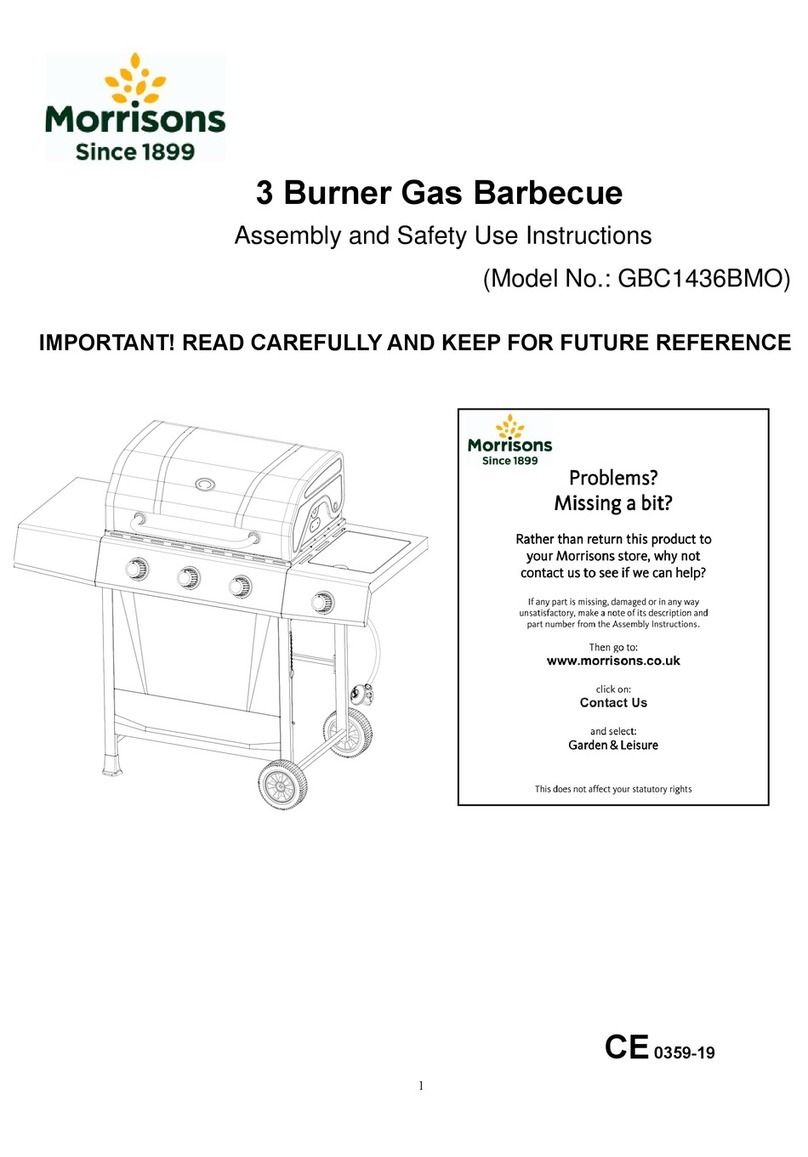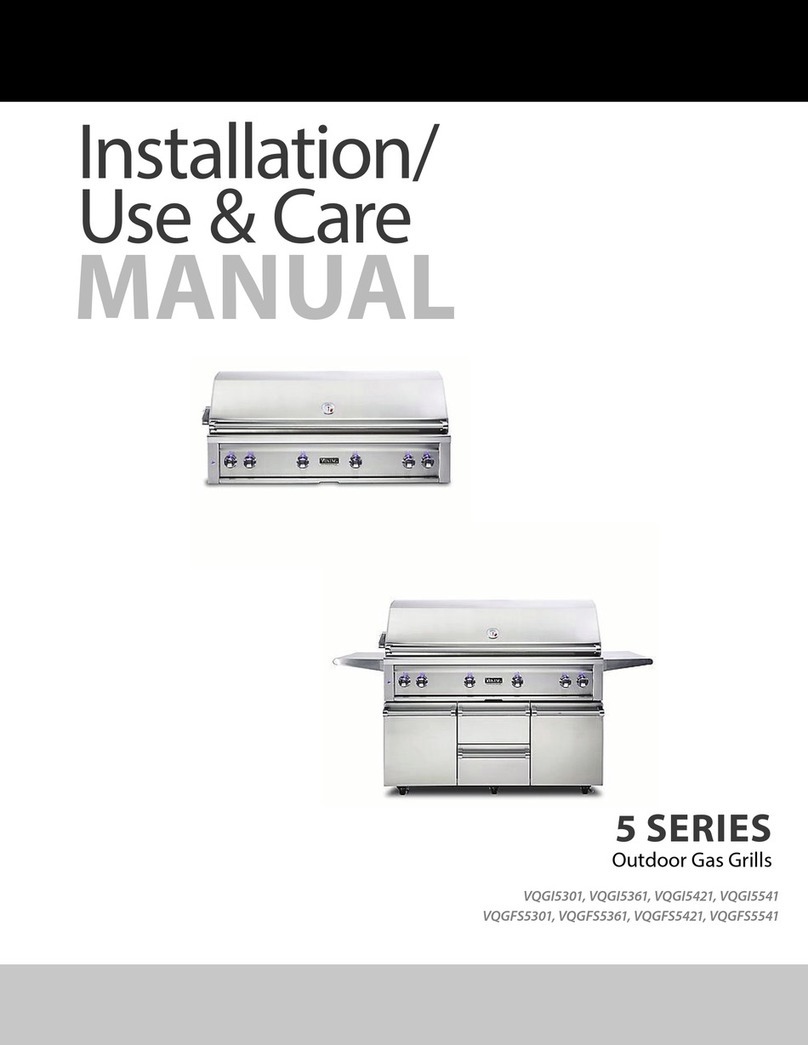Sub-Zero Wolf BBQ242BI User manual

Page 2
OOUUTTDDOOOORRBBBBQQGGRRIILLLLSS
General Information
1-2
TECHNICAL ASSISTANCE
If you should have any questions regarding a Wolf
appliance and/or this manual, please contact:
Wolf Appliance, Inc.
ATTN: Service Department
P.O. Box 44988
Madison, WI 53744-4988
Customer Service
Phone #: (800) 222-7820
Technical Assistance
Phone #: (800) 919 - 8324
Parts / Warranty Claims
Phone #: (800) 332 - 9513
Customer Service E-Mail Address
Customer Service & Technical Assistance
Facsimile #: (608) 441 - 5887
Parts / Warranty Claims
Facsimile #: (608) 441 - 5886
Office Hours:
7:00 AM to 7:00 PM Central Standard Time
Monday through Friday
This manual is designed to be used by Authorized Service Personnel only. Wolf Appliance, Inc. assumes
no responsibility for any repairs made to Wolf appliances by anyone other than Authorized Service
Technicians.
IMPORTANT SAFETY INFORMATION
Below are the Product Safety Labels used in this manu-
al. The "Signal Words" used are WARNING and
CAUTION.
Please note that these safety labels are placed in areas
where awareness of personal safety and product safety
should be taken and lists the precautions to be taken
when the signal word is observed.
INTRODUCTION
This Wolf Outdoor BBQ Grills Technical Service/Parts Manual, Part #803332, has been compiled to provide the most
recent technical service information about the Wolf Appliance, Inc. BBQ Grills. This information will enable the serv-
ice technician to troubleshoot and diagnose malfunctions, perform necessary repairs, and return a Wolf Outdoor
BBQ Grill to proper operational condition.
The service technician should read the complete instructions contained in this Training/Service Manual before initiat-
ing any repairs on a Wolf Appliance.
* Some information in section 2 (Theory of Operation) has been provided by the American Gas Association
and reprinted with their approval.
INDICATES THAT HAZARDOUS OR UNSAFE PRAC-
TICES COULD RESULT IN SEVERE PERSONAL
INJURY OR DEATH
Indicates that hazardous or unsafe practices could
result in minor personal injury or product and/or
property damage
In addition, please pay attention to the signal word
“NOTE”, which highlights especially important informa-
tion within each section.
The information and images are the copyright property of Wolf Appliance, Inc., an affiliate of Sub-Zero, Inc. Neither
this manual nor any information or images contained herein may be copied or used in whole or in part without the
express written permission of Wolf Appliance, Inc., an affiliate of Sub-Zero, Inc. © Wolf Appliance, Inc., all rights
reserved.

Page 3
General Information
1-5
OOUUTTDDOOOORRBBBBQQGGRRIILLLLSS
WARRANTY INFORMATION
This page contains a summary of the 2 & 5 Year
Warranty that is supplied with every Wolf product, fol-
lowed by details and notes about the warranties.
TWO & FIVE YEAR Warranty Summary
• Two year TOTAL PRODUCT warranty, parts and
labor.
• Limited Parts Only Warranty for the 3rd through 5th
year on the following parts only:
Gas Burners (excluding appearance)
LIMITED LIFETIME WARRANTY SUMMARY
• Repair or Replace any BBQ body which rust
through due to defective material or workmanship.
• Repair or replace any BBQ hood which rust
through due to defective material or workmanship.
• Labor to remove or replace defective parts is not
covered.
Warranty Details:
The warranty applies only to products installed for
normal residential use. The warranty applies only
to products installed in the United States or
Canada.
Warranty Notes:
• All warranties begin at the time of the units initial
installation.
•All Warranty and Service information collected by
Wolf Appliance, Inc. is arranged and
stored under the unit serial number and/or the cus-
tomer’s name. Please note that Wolf Appliance,
Inc. requests that you have the model
and serial number available whenever contacting
the factory or parts distributor.
•See Figure 1-1 for serial plate layout.
•See Figure 1-2 for serial plate location.
CERTIFIED
D
E
S
I
G
N
A
M
E
R
I
C
A
N
A
S
S
O
C
I
A
T
I
O
N
R
G S
A
C
E
R
T
I
F
I
E
D
R
WOLF
APPLIANCE CO. LLC FITCHBURG, WI
MODELBBQ-
SERIAL
NO.
GAS
GRILL ROTISSERIE
MAN.
PRESS.
OPEN
BURNER
INPUT RATING EACH
BURNER-BTU / HR.
ROTISSERIE MOTOR ELECTRICAL RATING
120V, 60 Hz, 0.58A
MINIMUM CLEARANCE FROM SIDES AND BACK OF UNIT TO ADJACENT
COMBUSTIBLE CONSTRUCTION BELOW TOP OF UNIT, 8 INCHES FROM
SIDES AND BACK. MINIMUM HORIZONTAL CLEARANCE FROM SIDES
AND BACK OF UNIT TO ADJACENT VERTICAL COMBUSTABLE
CONSTRUCTION EXTENDING ABOVE TOP OF UNIT, 6 INCHES FROM SIDES
ANS 12 INCHES FROM BACK. DO NOT LOCATE THIS UNIT UNDER
OVERHEAD UNPROTECTED COMBUSTIBLE SURFACES.
FOR OUTDOOR USE ONLY.
CAUTION:
1. DO NOT STORE A SPARE LP-GAS CYLINDER UNDER THIS
APPLIANCE.
2. NEVER FILL THE CYLINDER BEYOND 80 PERCENT FULL..
3. IF THE INFORMATION IN (1) AND (2) IS NOT FOLLOWED EXACTLY
A FIRE CAUSING DEATH OR SERIOUOS INJURY MAY OCCUR.
"ANSIZ21.58A CAN/CGA-1.6A-1998 OUTDOOR COOKING APPL.,"
"FOR INSTALLATION IN NON-COMBUSTIBLE LOCATIONS UNLESS
USED WITH APPROVED INSULATING JACKET" 800116
Figure 1-1 Typical Serial Plate Layout
FOR USE WITH AGAS PRESSURE REG-
ULATOR.THE REGULATOR SUPPLIED
MUST BE USED WITH THIS UNIT.
CET APPARIELREQUIERT L' INSTALLA-
TION D' UN DETENDEUR DE PRESSION.
LE DETENDEUR FOURNI DOIT Y ENTRE
INSTALLE.
WARNING: Improper installation
adjustment, alteration, service, or
maintenance can cause property
damage, injury or death. Read the
maintenance instructions thoroughly
before installing or servicing this
equipment.
MISE EN GARDE: Une mauvaise
installation, un mauvais entretien,
une reparation, un ajustement ou
une alteration inappropiee peuvent
causer des dommages a lappariel,
des blessures corporels ou la mort.
Lire les instructions d'installation,
de fonctionnement et d'entretien
avant l'installation ou lentretien de
cet appareil.
For Wolf Authorized Service
CALL
888-904-9653
CERTIFIED
D
E
S
I
G
N
A
M
E
R
I
C
A
N
A
S
S
O
C
I
A
T
I
O
N
R
G S
A
C
E
R
T
I
F
I
E
D
R
WOLF
APPLIANCE CO. LLC FITCHBURG, WI
MODELBBQ-
SERIAL
NO.
GAS
GRILL ROTISSERIE
MAN.
PRESS.
OPEN
BURNER
INPUTRATING EACH
BURNER-BTU/ HR.
ROTISSERIE MOTOR ELECTRICALRATING
120V,60 Hz, 0.58A
MINIMUMCLEARANCE FROM SIDES AND BACK OF UNIT TO ADJACENT
COMBUSTIBLECONSTRUCTION BELOW TOP OF UNIT, 8 INCHES FROM
SIDESAND BACK. MINIMUM HORIZONTAL CLEARANCE FROM SIDES
ANDBACK OF UNIT TO ADJACENT VERTICAL COMBUSTABLE
CONSTRUCTIONEXTENDING ABOVE TOP OF UNIT, 6 INCHES FROM SIDES
ANS12 INCHES FROM BACK. DO NOT LOCATE THIS UNIT UNDER
OVERHEADUNPROTECTED COMBUSTIBLE SURFACES.
FOROUTDOOR USE ONLY.
CAUTION:
1. DONOT STORE A SPARE LP-GAS CYLINDER UNDER THIS
APPLIANCE.
2. NEVERFILL THE CYLINDER BEYOND 80 PERCENT FULL..
3. IFTHE INFORMATION IN (1) AND (2) IS NOT FOLLOWED EXACTLY
AFIRE CAUSING DEATH OR SERIOUOS INJURY MAYOCCUR.
"ANSZ21.58A CAN/CGA-1.6A-1998 OUTDOOR COOKING APPL.,"
"FORINSTALLATION IN NON-COMBUSTIBLE LOCATIONSUNLESS
USEDWITH APPROVED INSULATING JACKET" 800116
Figure 1-2 The serial plate is located on the backside of
the Rear Hood Top.
Serial Plate

Page 4
OUTDOOR BBBQ GGRILLS
General Information
1-6
MODEL FEATURES:
All Models:
Wolf BBQ grills are constructed with heavy duty 18-gauge stainless steel. The hood is a two piece stainless steel
design with a handle. All grates are made from porcelainized cast iron. A grill scraper and protective cover is pro-
vided with each unit.
Wolf BBQ grills are assembled to either work with natural gas or LP gas. Converting a unit from one gas type to
another is not possible. There are built-in models and freestanding cart models. Cart models are currently equipped
with 5” locking swivel casters at both ends, with older models having non-swivel wheels at one end. The grill burner
tubes are made of stainless steel and have a 10,000 BTU (British Thermal Unit) rating. Every Wolf BBQ grill is also
equipped with a rotisserie burner, rated at 9,000 BTU’s, with a 115 volt rotisserie motor for turning the rotisserie rod.
Side Burner Models:
Some models are equipped with two porcelain cast iron side step-up burners. These burners have a 16,000 BTU
rating.
LP Gas Models:
LP gas units include a regulator, hose and 5-gallon LP tank.
MODEL NUMBER DESCRIPTIONS
This section briefly describes the reason for different model numbers. The BBQ’s are manufactured as either natural
gas or LP gas, built-in or on a free standing cart.
• The two digits “24”, “36”, “48” following the letters BBQ indicate the width of the grill chassis in inches.
Example: BBQ242C = 24” chassis.
• An additional number such as “2”, after the first two digits indicates there are two side step-up burners.
Example: BBQ242C = Two side step-up burners.
• The letter “C” which appears in some of the models is for cart.
Example: BBQ242C= Cart model.
• When there is “BI” in the model number, it indicates that the unit will be built in.
Example: BBQ242BI = Built in unit.
• The “-LP” at the end of the model number indicates the unit is manufactured to operate on LP gas.
Example: BBQ242C-LP = LP gas.
BBQ MODEL NUMBERS IN SUMMARY:
•BBQ = Grill
•24, 36, 48 = Indicates the width in inches of the grill chassis.
•2= This number following the first two digits indicates two side step-up burners.
•C= Cart
•BI = Built in.
•-LP = Indicates LP gas. When -LP is not at the end of the model number it indicates the unit is manufactured
for Natural gas.

Page 5
General Information
OUTDOOR BBBQ GGRILLS
MODEL NUMBER KEY
Refer to this key for an example of the model numbers.
Model: BBQ362BI-LP
Product Type
Size
Side Burners
Features
Fuel
Product Type
BBQ
Size
24 24 - Grill Space
36 30 - Grill Space
48 36 - Grill Space
Side Burners
2
Features
Built In
Cart
Fuel
LP Propane Gas
* No -LP indicates the unit is manufactured for Natural gas.

Page 6
OUTDOOR BBBQ GGRILLS
General Information Notes
1-8
TOP CONFIGURATIONS FOR OUTDOOR BBQ GRILLS
Configuration Model # Description
BBQ242BI
BBQ242BI-LP
BBQ242C
BBQ242C-LP
24” Grill with Two Open Burners, Built-In (Nat. Gas)
24” Grill with Two Open Burners, Built-In (LP)
24” Grill with Two Open Burners on 36” Cart (Nat. Gas)
24” Grill with Two Open Burners on 36” Cart (LP)
All 24” Grills have Four Grill Burners
BBQ36BI
BBQ36BI-LP
BBQ36C
BBQ36C-LP
36” Grill, Built-In (Nat. Gas)
36” Grill, Built-In (LP)
36” Grill on 36” Cart (Nat. Gas)
36” Grill on 36” Cart (LP)
All 36” Grills have Six Grill Burners
BBQ362BI
BBQ362BI-LP
BBQ362C
BBQ362C-LP
BBQ48BI
BBQ48BI-LP
BBQ48C
BBQ48C-LP
36” Grill with Two Open Burners, Built-In (Nat. Gas)
36” Grill with Two Open Burners, Built-In (LP)
36” Grill with Two Open Burners on 48” Cart (Nat. Gas)
36” Grill with Two Open Burners on 48” Cart (LP)
All 36” Grills have Six Grill Burners
48” Grill, Built-In (Nat. Gas)
48” Grill, Built-In (LP)
48” Grill on 48” Cart (Nat. Gas)
48” Grill on 48” Cart (LP)
All 48” Grills have Eight Grill Burners

Page 7
OUTDOOR BBBQ GGRILLS
Theory of Operation
2-2
THEORY OF OPERATION
A service technician should understand how a gas appliance operates before attempting to service the appliance.
This section provides descriptions of the different types of fuel gases and explains gas heating values. A definition
of specific gravity of gas is given along with its characteristics and effects. Gas combustion principles are explained
and gas burner components are described and illustrated. The end of this section contains illustrations which
demonstrate basic cooking appliance theory of operation.
Types of Fuel Gas:
Gases used to supply heat energy are called fuel gases. Common fuel gases are not simply one kind of hydrocar-
bon, they are mixtures of hydrocarbon gases. They contain other gases as well, such as free hydrogen, carbon
dioxide and nitrogen. As an example, natural gas might contain 85% methane, 12% ethane and 3% of other gases.
The presence of each of these gases in the fuel gas has some effect on the nature of the gas.
Some common fuel gasses are methane [CH4], ethane [C2H6], Propane [C3H8] and butane [C4H10]. Propane and
butane are nearly odorless. Natural gas that is processed to remove condensables and moisture, has little or no
odor and no color. Odorants are added to natural gas before distribution to aid in leak detection. A common odorant
used is a colorless liquid containing sulfur compounds.
Heating Value of Gas:
Heat energy produced when burning a fuel gas is commonly expressed in British Thermal Units (BTU). One BTU of
heat will raise the temperature of one pound of water one degree Fahrenheit.
The more carbon and hydrogen atoms in each molecule of a fuel gas, the higher its heating value. Natural gas
which is high in methane has a heating value of about 950 to 1150 BTU per cubic foot. The variance is due to the
various other substances found in natural gases. The more ethane, propane or butane in the gas raises the heating
value. Propane, or LP gas, has a heating value of about 2500-2800 BTU per cubic foot, and butane about 3200
BTU per cubic foot.
Specific Gravity of Gas:
The specific gravity of a gas is the weight of one cubic foot, or the gas compared to one cubic foot of dry air. When
stating the specific gravity of a gas, a pressure and temperature must be clearly stated. In the gas industry, the
standard conditions of pressure and temperature are 30.0 inches of mercury and 60° F. A pressure of 30.0 inches of
mercury will sustain a column of mercury 30 inches high in a tube with a vacuum on top of the column. Since air is
used as the reference, its specific gravity is always 1.0. This value of 1.0 has no direct physical meaning with
regard to air, such as its density. It is only a relative number or ratio used to express specific gravity of other gases.
The specific gravity of a gas will determine if the gas will rise or fall when released into the air. Natural gas will rise
since its specific gravity is less than 1.0 at 0.4 to 0.8. Propane has a specific gravity of 1.5 and butane 2.0. These
gases will fall when released into the air. They sometimes collect in low spots into pools which become a hazard if
open flames are present.
In addition, specific gravity has two other characteristics. It has an important effect on the flow of gases through ori-
fices, and hence the rating of the burners. Gas flow through an orifice is dependent upon the orifice size and the
gas pressure upstream of the orifice. More of a lighter gas will flow through a given orifice size than a heavier gas
at the same gas pressure. This effect is taken into account in tables and calculators used to select orifice sizes for
burners.
Specific gravity also affects gas flow in pipes. A given driving pressure at a pipe inlet will move more lighter gas
than heavier gas through that pipe.

Page 8
Theory of Operation
2-3
OUTDOOR BBBQ GGRILLS
Principles of Gas Combustion:
Combustion - When oxygen acts with a substance to produce large amounts of heat rapidly.
Requirements for Combustion - There are three required elements for combustion to occur; Fuel (Gas), Oxygen
(Air) and Heat (Ignition Temperature, which for gas is between 1100°F/593°C and 1200°F/649°C). All must be pres-
ent. Removing any one of the three and combustion will cease.
Chemistry of Combustion - Combustion of gas is a chemical reaction between fuel gas and oxygen. The basic
elements of common fuel gasses are hydrogen [H] and carbon [C]. When hydrogen burns, water vapor [H2O] is pro-
duced. Complete burning of carbon in fuel gases form carbon dioxide [CO2] and water vapor [H2O].
Controlled Combustion - Controlled combustion takes place when gas and air are supplied at proper rates to
assure complete combustion of the gas in a steady flame. When a gas appliance is operating properly, burning
starts at the burner ports. Gas flow is controlled by gas orifice size and gas pressure upstream of the orifice. Air is
mixed with the gas before it passes through the burner ports. This added air is called “Primary Air”. The remaining
air required for complete combustion is supplied to the burner at the point of combustion and is called “Secondary
Air”.
Adjustments of the gas-to-air ratio and the secondary air supply is the key to obtaining stable blue flames at a burn-
er. Proper amounts of primary and secondary air are required for quiet and efficient burner operation and for com-
plete combustion of the gas. Air Shutters or other devices provide control of primary air. Inlet opening and flue out-
lets control Secondary Air flow.
Total air - In an ideal situation, primary and secondary air is all that is needed (for the oxygen required) to burn the
gas, but some additional air is required to assure complete burning of the gas. The total air, “primary”, “secondary”
and “excess” are expressed as percentages of the amount needed. About ten cubic feet of air is required to com-
pletely burn one cubic foot of gas. For this reason an appliance should not be operated in an air tight home.
Limits of Flammability - Not all air-to-gas mixtures will burn. Mixtures with 0% - 4% natural gas in air are too lean
to burn. Mixtures of 4% - 14% natural gas in air can burn with a controlled flame. Flammability limits come into play
when primary air adjustments are made on burners. If too much primary air is used, the mixture may become too
lean and fall below flammability limits, thus preventing combustion.
Incomplete Combustion (Causes and Effects) - To obtain complete combustion, sufficient amounts of air must be
supplied to the process. This air must have a reasonably normal oxygen content. Complete burning of gas pro-
duces harmless carbon dioxide gas and water vapor. If the air supply is insufficient, incomplete combustion occurs
resulting in the formation of toxic by-products, such as carbon monoxide [CO] or aldehydes.
Carbon monoxide is colorless and odorless. Inhaling carbon monoxide in sufficient quantities could cause death by
reducing oxygen levels in the blood.
Aldehydes, which are equally dangerous, have a sharp and penetrating odor which is easily detected by smell at
very low concentrations. The odor caused by aldehydes should not be confused with odorants added to natural gas.
The absence of aldehydes does not assure that carbon monoxide is not present. However, if the odor of aldehydes
is present, then carbon monoxide is virtually always present.
Gas Burner Operation - A gas burner is a device to burn gas under control in order to produce useful heat.
Primary air is brought into the burner from outside of the appliance at atmospheric pressure. The gas jet streaming
from the orifice draws primary air with it into the burner.
The gas/air mixture, combined with a spark at the burner port(s) and the secondary air creates a controlled burn.

Page 9
OUTDOOR BBBQ GGRILLS
Theory of Operation
2-4
Burner Components:
Gas Orifice - An opening or hole which regulates or limits the amount of gas flowing to a burner. Gas flow rate (vol-
ume) depends on the size of the orifice (hole) and the gas pressure at the inlet of the orifice.
Air Shutter - This is used to adjust the size of the primary air inlet area and therefore controls primary air flow.
Venturi Tube - A section of pipe at the inlet of the burner body that narrows and then flares out again. This tube
helps maintain a proper and constant primary air injection.
Mixing Tube/Throat - Serves to carry the gas/air mixture from the venturi tube to the burner body.
Burner Body - The accumulation chamber below the burner base which allows the gas and air to mix together fully.
Burner Head - The component containing the burner ports where the gas/air mixture ignites. The burner ports are
distributed in a useful pattern to optimize heat transfer. The flames should be spread so they can be easily reached
by secondary air and provide a stable blue flame.
Air Shutter
Air Shutter
Burner Head
Mixing Tube/Throat
Burner Body
Venturi Tube
Venturi Tube
The Gas Orifice or hole
regulates or limits the amount
of gas flowing to a burner.
The part which contains the orifice
should be referred to as an orifice
Spud, Hood or Cap.
Fig. 2-1
Fig. 2-2 Fig. 2-3

Page 10
Theory of Operation
2-5
OUTDOOR BBBQ GGRILLS
Types of Burners:
Blue Flame Burners - All Wolf BBQ burners are blue flame burners. With this type of burner, primary air is mixed
with the fuel gas before the gas reaches the burner ports. An orifice is used to regulate gas flow to the burner. Air
which is mixed with the gas inside of the burner body enters through openings in the burner body. A shutter or ven-
turi tube is used to adjust the size of these openings and control the primary air. Gas and air mix in the mixing tube
or throat, which then exits the burner ports where it is ignited. Secondary air is air from around the flames. The
flame produced has several zones, each represents a stage in burning of the gas. The burner tip has a thin dark
blue cone called the inner or primary cone. A lighter cone called the outer cone, surrounds the inner cone. Air
around the flame diffuses into the flame to burn at the outer cone. If conditions are perfect, products from the inner
cone burn here. The final products of burning are carbon dioxide and water vapor. An outer mantle surrounds the
outer cone where burning is usually completed. It is nearly invisible and glows only because of the high temperature
of the final combustion.
Infrared Burner - All Wolf gas BBQ’s use an infrared burner for the rotisserie. This infrared burner is a porous
refractory ceramic tile burner, similar to the infrared burner used in the ranges and cooktops. (See Figure 2-4) With
infrared heat, thermal energy is transmitted through space without heating the medium through which it travels.
Infrared energy is usually not affected by air flowing between the burners and heated surfaces because of the burn-
er’s numerous and tiny flames. This type of heat is very efficient and compact. The refractory ceramic infrared
burner requires 100 percent primary air and is designed to have a hot glowing burner surface. The flame burns
close to the burner surface at a high temperature.
NOTE: There is not a shutter on infrared burners for adjusting the primary air.
Fig.2-4
Porous Ceramic Surface

Page 11
OUTDOOR BBBQ GGRILLS
Theory of Operation
2-6
Operation of the Wolf BBQ Grill
About the Wolf BBQ
The grill grates are composed of five-inch heavy duty porcelain cast iron and are designed for easy handling and
cleaning. Just below the grill surface are the stainless steel heat radiants which concentrate the heat. The Wolf
BBQ design eliminates the use of briquettes or lava rock. BBQ burners produce 10,000 BTU/hr and are located
every five inches across the bottom of the unit. The optional open top side burners are rated at 16,00BTU/hr and
have a spark igniter for rotary knob lighting.
Lighting Instructions
The Wolf BBQ Grill is pre-set for the gas specified when the unit is purchased,
either natural or LP gas. The properly adjusted flame should have a bluish-green
inner cone and a dark blue outer mantle. The flame should be clean and soft
with no yellow tips. Blowing or lifting of the flame should not occur. If the air
shutters are not visible as in Fig. 2-5, the shutter adjustment is
made by loosening the air shutter screw, setting then retightening.
(This should give you proper mixture of the air and gas.)
Before Lighting
Prior to lighting, inspect the gas supply piping or hose. Look for evidence of
abrasion, cuts, wear and tear, or other damage which would require replacement
prior to use. Make sure all burner control knobs are in the OFF position. Do not
attempt to light the burners if the smell of gas is present. Make sure there is
gas in the cylinder and the cylinder is upright. Make sure all radiants are positioned
properly over the grill burners.
Lighting the Grill
1. Open the hood.
2. Push in the gas control knob for the grill and turn counter clockwise to HIGH.
3. Keep your face as far away from the burners as possible.
4. Turn the black igniter knob clockwise which corresponds with the gas control knob you have turned on until you
hear a loud click. Repeat immediately if the burner does not light on the first try.
5. Listen for a “whoosh” sound. If the burner does not light by the fourth attempt with the igniter, turn the control
knob to the OFF position. Wait five minutes until the gas clears.
6. Repeat the procedure or refer to the Manual Lighting Procedure.
7. If the burner is lit, you can see flames by looking through a series of holes just above the control knob of
the corresponding burner.
8. Upon successful lighting, repeat the process on the other burners as needed
Lighting the Open Burners
1. Remove the open burner cover or any utensils from the grate.
2. Follow the steps as above in lighting the grill.
NOTE: The front and rear open burners are lit by a single electrode. The igniter knob is the same for the front and
rear open burners.
Lighting the Rotisserie Burner
The position of the infrared rotisserie burner makes it more susceptible to be blown out and should not be used if
windy conditions prevail or in an unprotected area. For this reason the burner is equipped with a safety valve which
will not allow the burner to operate unless the pilot is lit.
1. Open the hood and remove the rotisserie burner cover.
2. Push in and turn the rotisserie gas control knob to HIGH.
3. After 15 to 30 seconds, turn the rotary igniter knob clockwise until a clicking sound is heard. (This will give the
gas enough time to travel through the tubing to the pilot at the left corner of the burner.)
4. Once the pilot is lit, the burner will light in approximately 30 seconds. The flame is not visible but will give off
heat and a red-orange glow after a few minutes.
Fig. 2-5
1/16” for Natural
1/4” for LP
Air Shutter Screw

Page 12
Theory of Operation
2-7
OUTDOOR BBBQ GGRILLS
Manual Lighting Procedure
You may manually light the grill burners by inserting the match/lanyard holder or a butane lighter into the 1/2” diame-
ter hole above the grill valve knob (Fig. 2-6). Position the match or the lighter tip near the burner ports, push and
turn the knob counter clockwise to HIGH and light the burner. Repeat for the other burners.
The open burners can be lit directly from the top along the orifice holes around the burner heads. (Fig. 2-8)
The rotisserie burner must be lit at the pilot. Once the pilot is lit, the burner will light within 30 seconds. (Fig. 2-7)
Fig. 2-7Fig. 2-6
Position the Match/Lanyard with a lit
match over the Open Burner Head.
Push and turn Burner Valve Knob
counter clockwise to HIGH and light
burner.
Fig. 2-8
Use Match/Lanyard to
light Rotisserie at Pilot
Insert Match/Lanyard
to manually light Grill

Page 13
OUTDOOR BBBQ GGRILLS
Theory of Operation
2-8
Cleaning and Maintenance
Burner Grates
The grates are composed of durable cast iron with a
porcelain enamel finish. Operating the grill on High for
a few minutes after cooking will help to burn off any
excess food. The wire brush included with the BBQ
can be used to clean the grill grates. Once the grates
have cooled, they can be lifted off and sprayed with a
commercial grill and stainless cleaner. They must be
rinsed and dried before they are put back into place.
Open Burner Grates
These grates are porcelain cast iron and can be wiped
clean while in place. They can also be removed when
cool and cleaned with warm soapy water.
Open Burner Heads
Simply lift the removable porcelain cast iron burner
heads straight up. Clean clogged gas holes with an
open paper clip or wire. Wash with soapy water, dry
and replace.
Venturis
Spiders or small insects may spin webs or build nests
inside of the venturis. This especially occurs in late
summer and fall when spiders are most active. These
nests can obstruct gas flow and cause a fire in and
around the valve. Such a fire can cause operator injury
and serious damage to the grill.
To help prevent a blockage and ensure full heat output,
follow these steps to clean and inspect the venturis
once or twice a month.
1. Using a flashlight, look inside of the end of the burn-
ers for webs or mud nests. See Fig. 2-9
2. Use the special venturi brush provided and push the
brush through the full length of each burner several
times. See Fig. 2-9
3. For the grill venturis, clean the gas holes with a
paper clip if blocked. See Fig. 2-10
4. Replace the venturis and make sure the bell shaped
or cylindrical end is located over the valve orifices.
See Fig. 2-11
5. Test light to see if it is burning properly.
Grill Tank Bottom
If there is an accumulation of carbon or burned food on the bottom of the grill, use a spatula or scraper to push all
of the carbon and food to the front and into the drip pan to collect and dispose.
Drip Trays and Grease Cans
After cooling, the drip trays and grease cans may be removed and cleaned. The grease can should be cleaned after
each use.
Fig. 2-9
Fig. 2-10
Fig. 2-11

Page 14
OUTDOOR BBBQ GGRILLS
Installation Information
3-2
Insulated Jacket
The optional insulated jacket is necessary when the non cart grill is to be installed into a combustible enclosure.
Use only the Wolf approved insulated jacket which has been specifically designed and tested for this purpose.
See Fig. 3-2
Clearance to Combustible Construction
A minimum of 12” from the sides and 12” from the back is required above and below the cooking surface to adjacent
vertical combustible surfaces as shown on page 3-3. A minimum of 4-1/2” from the back is required for the hood to
open and 6” to the side is required for the rotisserie motor. Refer to the illustrations and chart on page 3-3.
INSTALLATION INFORMATION
This section of the manual covers some of the installation issues that a service technician may need to know when
servicing a Wolf BBQ. If additional installation information is needed after reviewing this section of the manual,
please refer to the Installation Guide or contact the Wolf Appliance Customer Service Department.
Electrical Requirements:
A Wolf BBQ rotisserie motor requires 110-120 volts AC to
operate. The power supply cord on the rotisserie motor is
equipped with a 3-prong (grounding) plug. The installation
site must be equipped with a properly grounded 3-prong
receptacle. If the electric receptacle or the power cord are
not properly grounded and polarized, a shock hazard could
exist and the rotisserie motor may experience problems.
(See Figure 3-1)
Neutral Line
Voltage
(Power)
Ground
Fig. 3-1. Proper Polarity at Electric Receptacle
TOAVOID SHOCK HAZARD, NEVER REMOVE THE
GROUNDING PRONG FROM THE PLUG OF THE
POWER SUPPLYCORD.
Note: Keep electrical supply cords and the fuel supply
hose away from heated surfaces.
Fig. 3-2 Insulated Jacket

Page 15
Installation Information
3-3
OUTDOOR BBBQ GGRILLS
Pre-Installation Specifications
Overall / Pre-Installation Dimensions Model BBQ242 Model BBQ36 Model BBQ362 Model BBQ48
AOverall Width of Grill 36” 36” 48” 48”
B Width of Hood 24” 36” 36” 48”
C Rough Opening Width (Combustible Enclosure) 38 1/4” 38 1/4” 50 1/4” 50 1/4”
D Rough Opening Width (Non-Combustible Enclosure) 36 1/4” 36 1/4” 48 1/4” 48 1/4”
Pre-Installation Dimensions Combustible Enclosure Non-Combustible Enclosure
E Rough Opening Depth 27 3/4” 26 3/4”
FRough Opening Height 10 1/2” 9 1/2”
G Minimum Clearance to Side Walls 12” 6”
H Minimum Clearance to Back Wall 12” 4 1/2”
I Gas Supply Location (Back Wall/Bottom Location) 3 1/8” 2 1/8”
J Gas Supply Location (Back Wall Location) 3 3/4” 2 3/4”
K Gas Supply Location (Bottom Location) 2 7/8” 1 7/8”

Page 16
OUTDOOR BBBQ GGRILLS
3-4
Installation Information
Gas Requirements
Gas Pressure:
NOTE: All Wolf BBQ’s are manufactured as either natural gas or LP gas.
Natural Gas Manifold Pressure
Standard natural gas orifices on the BBQ are set for 5” WC (Water Column Pressure). A natural gas regulator is
provided.
Liquid Propane (LP) Manifold Pressure
Standard LP gas orifices on the BBQ are set for 10” WC (Water Column Pressure). An LP gas regulator is provided.
Gas Supply Pressure
• Maximum line pressure for natural gas and LP is 14” WC; 1/2 psi (3.5 kPa).
• Minimum line pressure for natural gas is 7” WC.
• Minimum line pressure for LP gas is 11” WC.
Gas Pressure Regulator
To control and maintain a uniform gas pressure in the gas manifold, Wolf gas appliances must be connected to the
gas supply line through a pressure regulator. The burner orifices are sized for the pressure delivered by the regula-
tor. Never attempt to operate a Wolf gas appliance without the use of the proper pressure regulator.
The maximum gas supply pressure to the regulator is 14” WC (Water Column Pressure); 1/2 psi (3.5kPa) and
should not be exceeded.
Natural Gas Hook-Up
Hook-up to a natural gas supply is made from the rear right side with fittings and a regulator. The coupling, pipe,
nipple, street elbow and regulator are provided. To hook up the fittings refer to Fig. 3-3. Make sure the flow arrow
on the regulator points in the direction of the gas flow from the gas supply to the grill. See Fig. 3-4
3/4" x 3" Pipe Nipple
3/4" Coupling
3/4" x 3/4" Street Elbow
Regulator
3/4" x 1/2" Adapter*
1/2" Close Nipple*
Shut Off Valve*
(must be easily accessible)
* Indicates parts not included
Manifold Pipe
Fig. 3-3 Fig. 3-4
To Grill
Vent
From Gas Supply

Page 17
Installation Information
3-5
OUTDOOR BBBQ GGRILLS
LP Gas Hook Up
An LP Wolf BBQ is equipped with a five foot hose, regulator and unfilled 20 pound gas cylinder. This connection is
done with the cylinder located inside of the cart. See Fig. 3-5 and Fig. 3-6
Cylinder Specifications
The LP gas supply cylinder used with this grill must be approximately 12” in diameter and 18” high. The maximum
fuel capacity is 20 lbs. of propane or 5 gallons. Full cylinder weight should be approximately 38 lbs. (43.7 lbs. nomi-
nal water capacity). The LP gas supply cylinder must be provided with a listed over-filling prevention device. (DPD)
Approximate running time for a 20 pound LP tank:
BBQ Model # BTU Rating Running Time
BBQ36 / BBQ36C 69,000 BTU 6-1/2 hours
BBQ242 / BBQ242C 80,000 BTU 5-1/2 hours
BBQ48 / BBQ48C 89,000 BTU 5 hours
BBQ362 / BBQ362C 101,000 BTU 4-1/2 hours
Fig. 3-5
Coupling Nut
Manifold Pipe
LP Gas Cylinder
(Use in upright position only)
Regulator with 5' Hose
VENT
VENT
VENT HOLE ON REGULATOR MUST POINT DOWN TO
PREVENT FREEZE UP DURING OPERATION OF GRILL
Vent Hole
VENT
To LP
Cylinder To Grill
Vent
NOTE: When connecting the regulator
with hose, you must coil excess hose
around LP Cylinder. Failure to do so could
result in pulsating flames or partial flame.
Fig. 3-6

Page 18
OUTDOOR BBBQ GGRILLS
Installation Information
3-6
Installation Checklist
- All internal packaging has been removed.
- All shipping restraints have been removed from the burners.
- Specified clearances to any combustible materials have been maintained.
- All burners light properly, individually and simultaneously.
- All flames appear normal
- The drip pan slides freely. The grease can is properly placed.
- The pressure regulator is connected.
- The LP cylinder is in an upright position and the hose is not kinked.
- The unit has been tested and is free of leaks.
- The customer has been informed of the gas supply shut off valve locations.
- Radiants are located properly over the grill burners.
Leak Testing
A leak test should be performed every time the gas cylinder is connected to the regulator, and whenever part of the
gas system is disconnected or replaced. This applies to both natural and LP gas.
Test for leaks at the cylinder valve, cylinder welds, regulator (especially attached to cylinder valves), hose and con-
nections.
NOTE: DO NOT use a flame, such as a lighted match to test for leaks. Use only a leak testing solution of soapy
water or an electronic leak detector.
Leak Testing Procedure
1. Check that all control knobs are in the OFF position.
2. Mix a one-part soap/one-part water solution. (If not using an electronic detector.)
3. Turn the cylinder valve knob counter-clockwise one turn to open.
4. Apply the soap/water solution on the joints of the gas delivery system.
5. The appearance of blowing bubbles in the soap solution indicates that a leak is present.
6. Stop the leak by tightening the loose connection or replacing the faulty part.
DO NOT attempt to repair the cylinder valve if it should become damaged. The cylinder must be replaced.
NOTE: It is important that there are no leaking connections on the BBQ grill. Refer to the Leak Testing Procedure.

Page 19
OUTDOOR BBBQ GGRILLS
Component Removal
COMPONENT ACCESS AND REMOVAL
This section explains how to access and remove components from a Wolf Outdoor BBQ Grill. Depending on which
component you are going to access or remove in the following sections, you may have to remove some components
first. Refer to the appropriate section in this manual that explains how to access and remove those various compo-
nents. When reassembling, just reverse the steps that were used to acces and remove the components.
NOTE: Before attempting to access or remove any components from a Wolf Appliance, take note of the following
warnings.
-TOAVOID SERIOUS BURNS AND/OR EXPLOSIONS, KEEP COMBUSTIBLES AWAYFROM THE APPLIANCE
WHENEVER AFLAME IS PRESENT. KEEP IN MIND THAT SURFACES AND COMPONENTS GET HOT
DURING THE USE OF THE APPLIANCE.
-TO AVOID ELECTRICAL SHOCK, POWER TO THE UNIT MUST BE DISCONNECTED WHENEVER ACCESS
ING AND/OR REMOVING COMPONENTS POWERED BY ELECTRICITY OR COMPONENTS NEAR OTHER
ELECTRICAL COMPONENTS.
-IF IT IS NECESSARYTO REMOVE AUNIT FROM ITS INSTALLATION, REMEMBER THAT THE UNIT COULD
TIP FORWARD WHEN PULLED FORWARD, RESULTING IN SERIOUS INJURYOR DEATH. PULLING A
UNIT FROM ITS INSTALLATION SHOULD ONLYBE DONE BY AN AUTHORIZED SERVICE TECHNICIAN OR
INSTALLER.

Page 20
Component Removal
OUTDOOR BBBQ GGRILLS
OPEN BURNER COMPONENTS:
Components include; Open Burner Cover, Open Top
Grates, Step Up Frame, Burner Head, Front & Rear
Venturi, Spark Ground Strap, Spark Electrode, Spark
Electrode Mounting Bracket and Pilot Tube Bracket,
Burner Support Bracket
Open Burner Cover
The stainless steel open burner cover protects the open
burners from the weather when the open burners are
not is use. To remove the open burner cover, lift the
cover off. See Fig. 4-1
Fig. 4-1
Fig. 4-2
Fig. 4-3
Open Top Grates
The open top grates are used to place pots and pans
on the open top burners for cooking. To remove the
open top grates, lift them off of the open top frame.
See Fig. 4-2
Step-Up Frame
The step-up frame is stainless steel and is used to ele-
vate the rear open top burner. To remove the step-up
frame you will need to extract the screws at the back of
the frame which mount it to the BBQ chassis. Now, lift
off the step-up frame from the chassis. See Fig. 4-3
Fig. 4-4
Burner Head
The burner head is made of cast iron and consists of
numerous holes that the gas and flame come out of. To
remove the burner head, lift the burner head off of the
burner venturi. See Fig. 4-4
This manual suits for next models
15
Table of contents
Popular Grill manuals by other brands

nomadiQ
nomadiQ CQ_BBQ_001 instruction manual
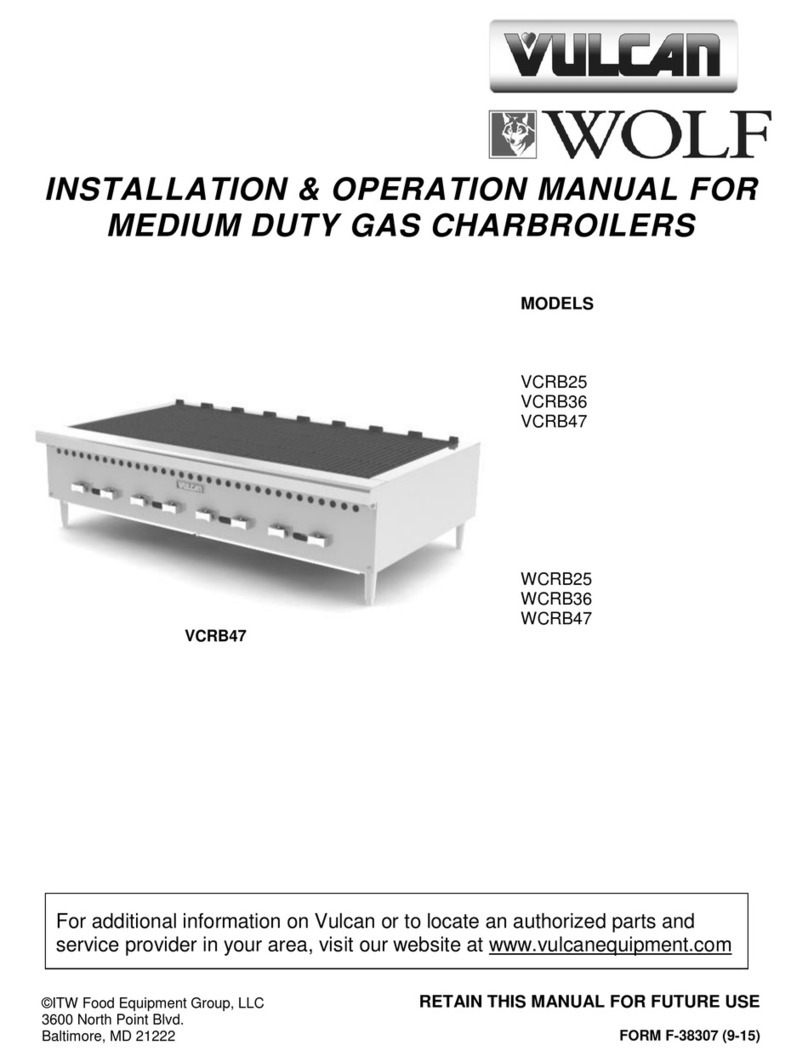
Vulcan-Hart
Vulcan-Hart Wolf VCRB25 Installation & operation manual
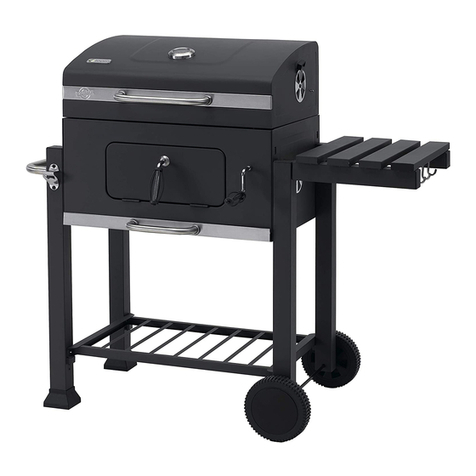
tepro
tepro TORONTO instruction manual
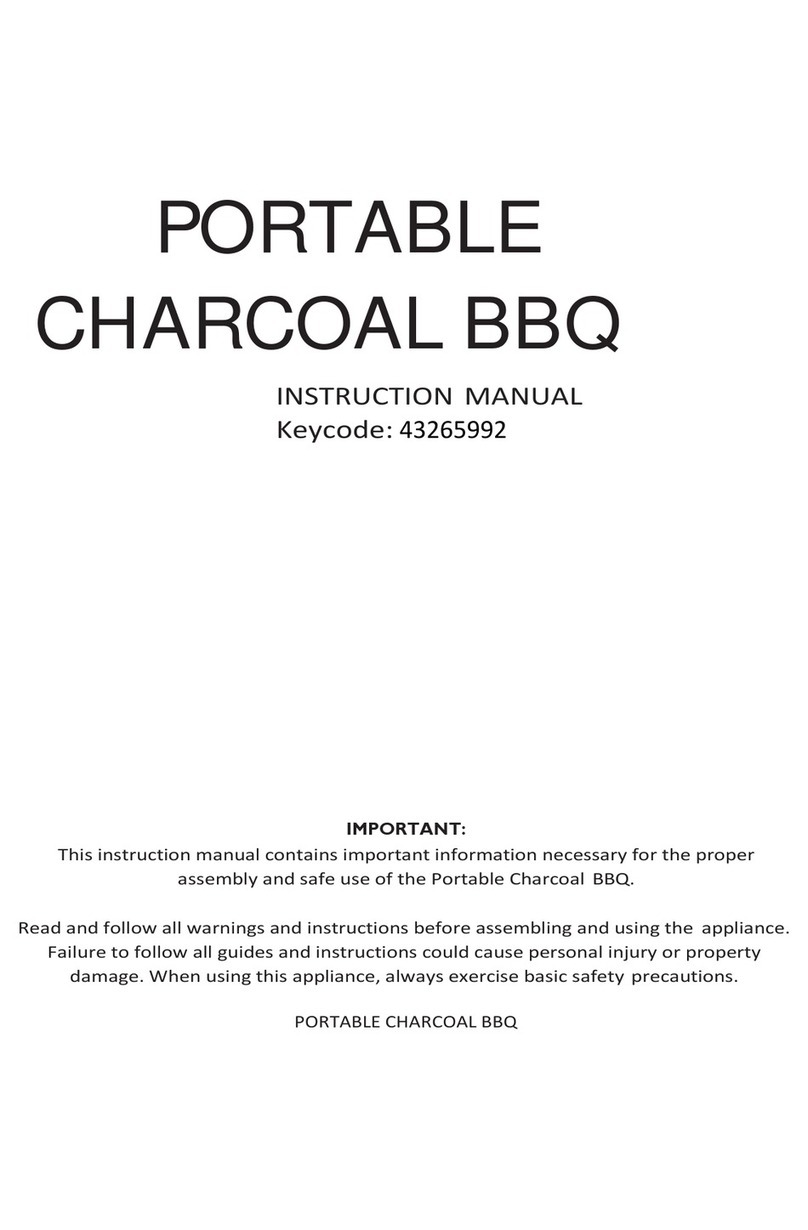
KMART
KMART 43265992 instruction manual
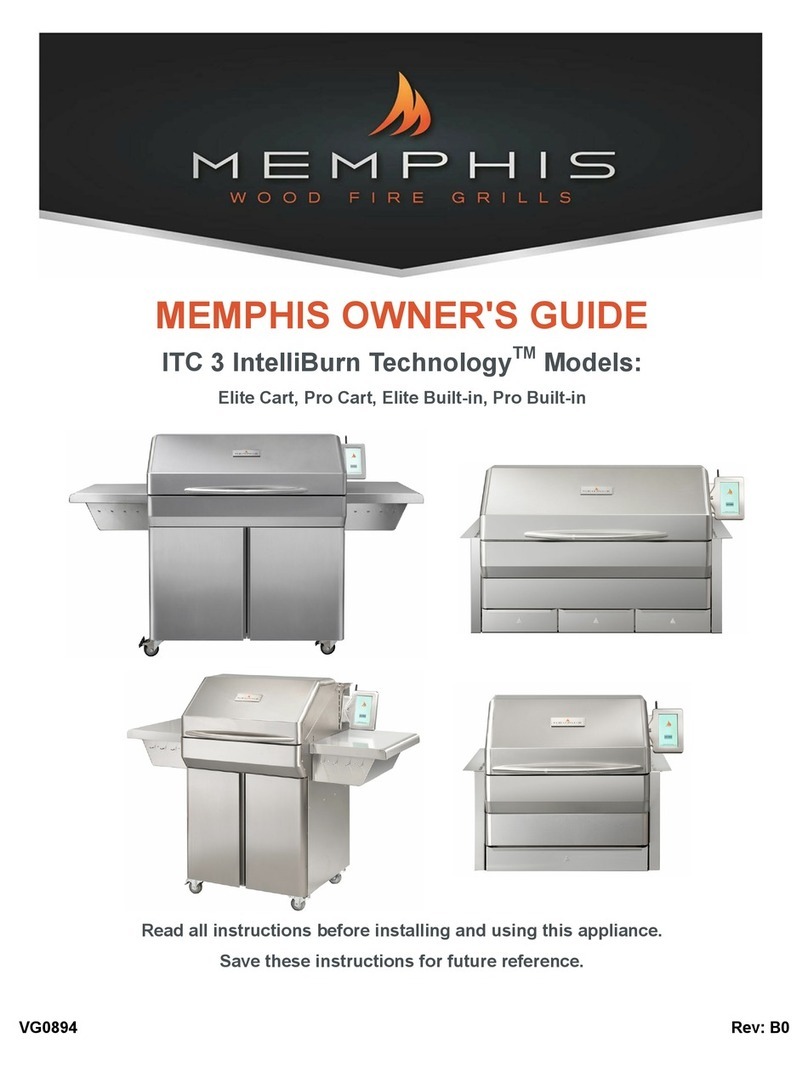
Memphis
Memphis ITC 3 IntelliBurn Technology Elite Cart owner's guide
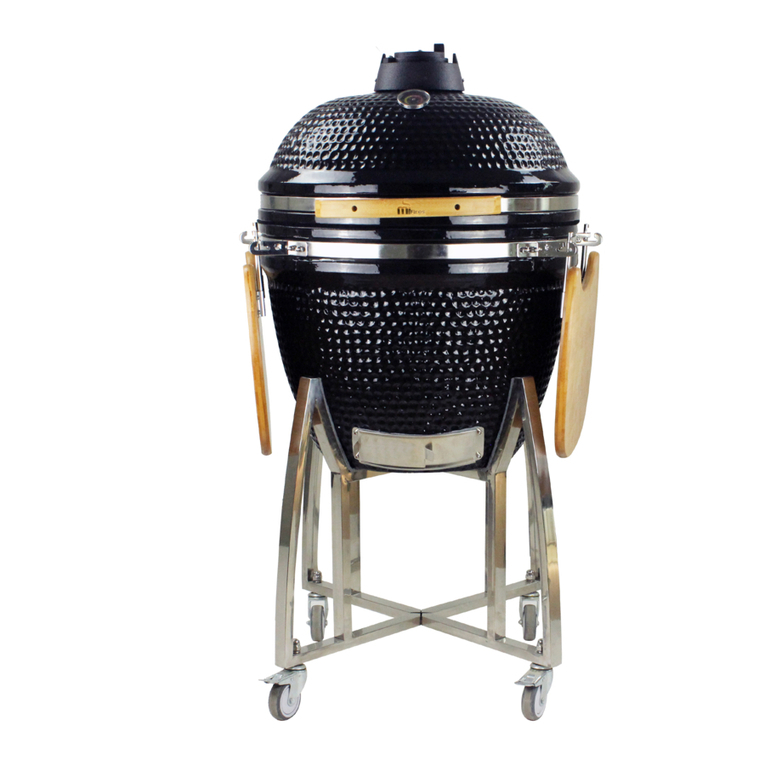
Mi-Fires
Mi-Fires Mi-Kamado Installation and operation manual
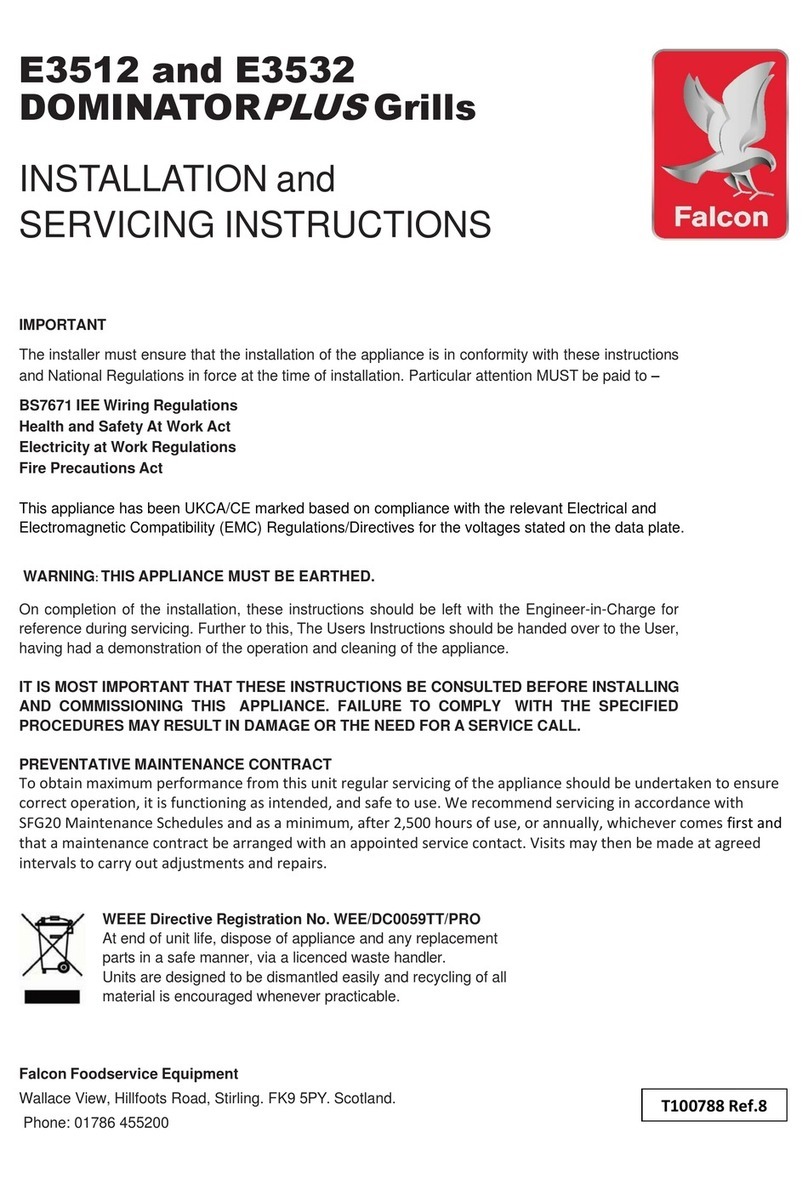
Falcon
Falcon DOMINATORPLUS E3512 Installation and servicing instruction
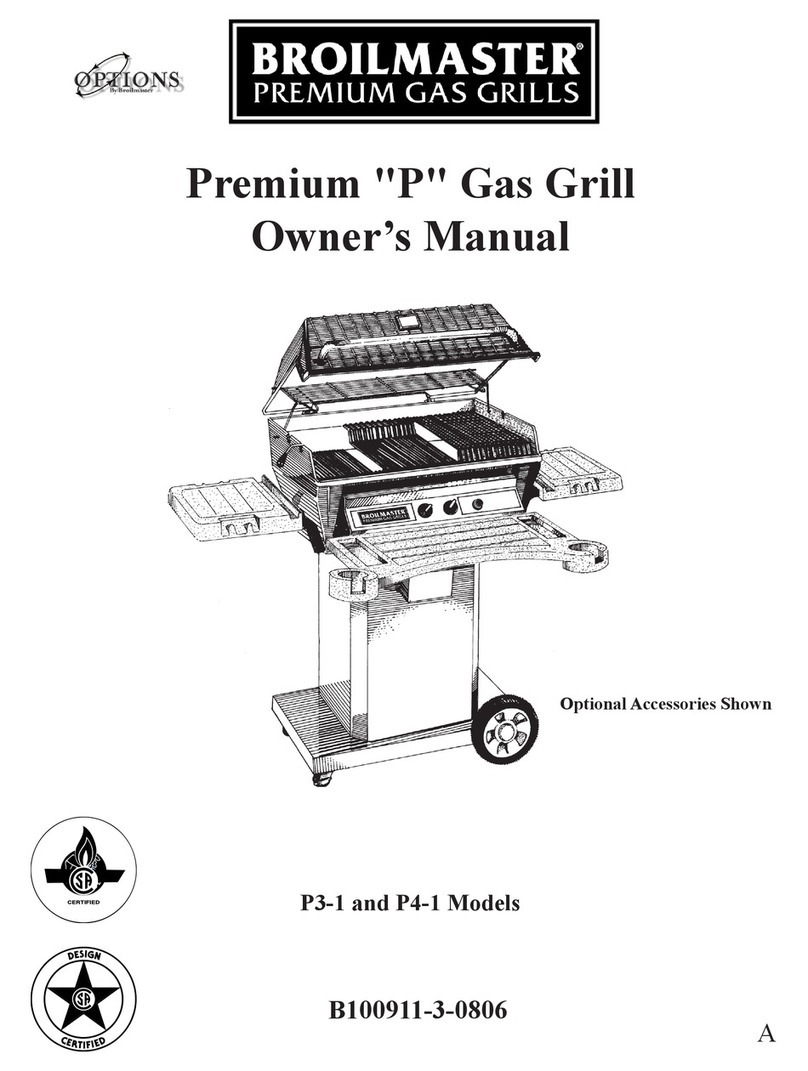
Broil King
Broil King Premium P3-1 owner's manual

Thermos
Thermos 461320507 Product guide
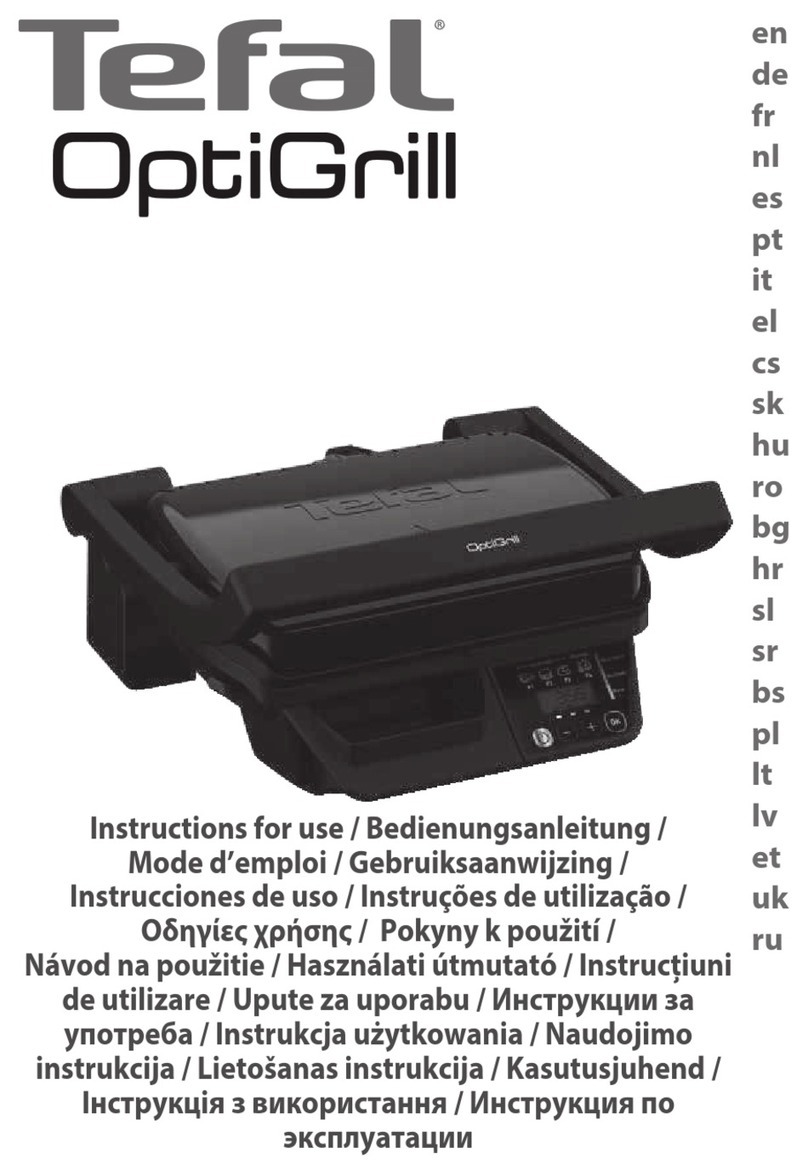
TEFAL
TEFAL OPTIGRILL Instructions for use

Inoksan
Inoksan PERFECT 700 Series instruction manual
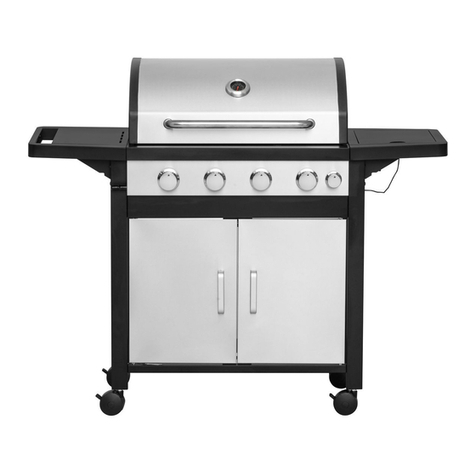
Mustang
Mustang MONTEREY 4+1 Assembly and operating instructions


